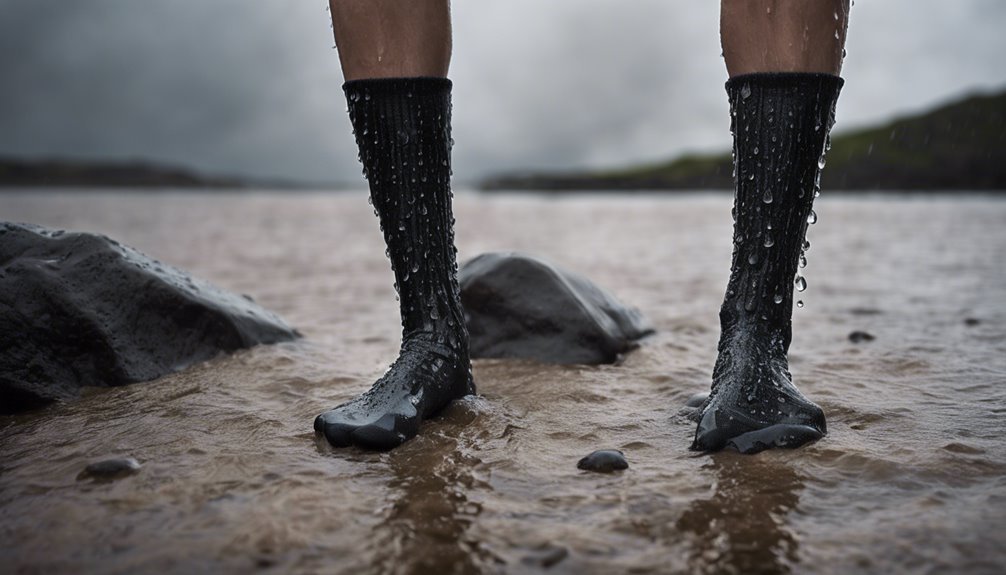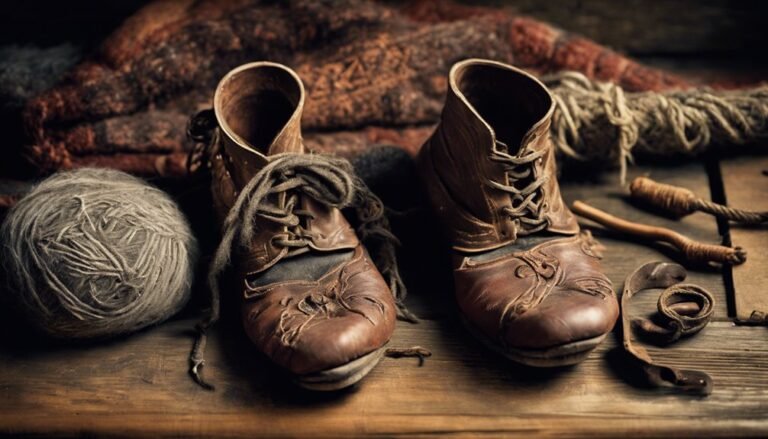Waterproof Socks vs. Quick-Dry Socks: Which Works Better in the Rain?
When deciding between waterproof socks and quick-dry socks for rain, consider their distinct benefits. Waterproof socks create a moisture barrier to keep your feet dry, while quick-dry socks wick moisture away for efficient evaporation. If you're facing constant wet conditions, waterproof socks may be best. However, for activities with occasional splashes, quick-dry socks excel in moisture management. Your choice ultimately depends on activity type and weather. Explore further to discover which sock is right for your needs.
Understanding Waterproof Socks

Waterproof socks are designed to keep your feet dry in wet conditions, making them essential for outdoor activities like hiking, fishing, or even walking in the rain. These socks often feature a waterproof membrane that prevents water from penetrating while allowing moisture to escape, ensuring comfort. Their insulation properties help maintain warmth, especially in colder climates, while also providing effective temperature regulation. This means your feet won't overheat or get cold, enhancing your overall experience during outdoor adventures. The combination of waterproof materials and thoughtful design makes these socks a valuable addition to your gear. When you prioritize freedom in your activities, having reliable waterproof socks can greatly enhance your enjoyment and performance, no matter the weather.
Benefits of Waterproof Socks
When you're out in the elements, having the right gear can make all the difference in your comfort and performance. Waterproof socks offer a blend of waterproof technology and sock insulation, ensuring your feet stay dry and warm even in the harshest conditions. Here are some key benefits:
| Benefit | Description | Impact |
|---|---|---|
| Dryness | Keeps moisture out, preventing blisters | Enhances comfort |
| Insulation | Retains warmth despite wet conditions | Maintains foot temperature |
| Versatility | Suitable for various outdoor activities | Expands usage options |
With these features, you can confidently tackle rain-soaked trails, knowing your feet are protected. So, if you're seeking freedom in your adventures, waterproof socks are a worthwhile investment.
Limitations of Waterproof Socks
While waterproof socks offer protection from moisture, they can also come with significant limitations. You might find that their breathability is compromised, leading to uncomfortable moisture buildup inside the sock. Additionally, durability can be a concern, and the higher cost compared to other sock options may not justify the benefits for everyone.
Breathability Issues
Although waterproof socks offer protection against moisture, they often struggle with breathability, which can lead to discomfort during extended wear. You might find that these socks create breathability challenges, causing your feet to feel hot and sweaty. The impermeable layers designed to keep water out can also trap heat and moisture inside, resulting in moisture retention that's uncomfortable over time. As your feet sweat, the lack of ventilation can create a damp environment, increasing the risk of blisters and irritation. If you're seeking a balance between protection and comfort, you might want to contemplate quick-dry socks, which allow for better airflow while still offering some moisture management. Ultimately, finding the right sock for your needs is key to enjoying your outdoor adventures.
Durability Concerns
Breathability issues aren't the only concern when it comes to waterproof socks; their durability can also be a significant limitation. While these socks are designed to withstand wet conditions, they often face increased wear and tear, particularly in high-friction areas like the heels and toes. Over time, this can compromise their waterproof features, leading to leaks. When you compare the lifespan of waterproof socks to quick-dry options, the latter often outlasts them regarding overall resilience. Quick-dry socks may not be completely waterproof, but they typically maintain their integrity longer, making them a better choice for adventurous souls who require durability. Ultimately, if you're seeking freedom in your outdoor activities, consider the durability factors carefully.
Cost Considerations
When considering waterproof socks, it is essential to take cost into account, as they often come with a higher price tag than quick-dry alternatives. A thorough cost analysis reveals that while waterproof socks provide superior wet-weather protection, their initial investment can be considerable, often ranging from $30 to $60 per pair. For those on a tighter budget, quick-dry socks, which typically cost between $10 and $30, might be a more viable option. Additionally, factor in the longevity of each type; if waterproof socks last markedly longer, they could save you money in the long run. Ultimately, your budget considerations should align with your specific needs and how often you'll be facing rainy conditions. Choose wisely to maximize your investment.
Understanding Quick-Dry Socks

Quick-dry socks are typically made from synthetic materials like polyester or nylon, which enable efficient moisture management. These fabrics wick moisture away from your skin, allowing sweat to evaporate quickly, keeping your feet dry and comfortable. When comparing drying speeds, quick-dry socks generally outperform traditional cotton, making them ideal for active use or variable weather conditions.
Material Composition Differences
Understanding the material composition of quick-dry socks is essential for anyone seeking superior performance in wet conditions. These socks primarily use synthetic fibers, which are designed to wick moisture away and dry quickly. Unlike waterproof membranes found in waterproof socks, quick-dry socks rely on breathability and moisture management.
Here are some key components of quick-dry socks:
- Nylon: Durable and water-resistant, enhancing longevity.
- Polyester: Known for its moisture-wicking properties, it helps keep your feet dry.
- Spandex: Offers stretch and comfort, ensuring a snug fit.
- Merino Wool: Provides natural insulation and breathability, great for temperature regulation.
These materials work together to provide effective moisture management, making quick-dry socks a reliable choice for rainy adventures.
Moisture Management Techniques
Moisture management techniques are essential for keeping your feet dry and comfortable during any activity. Quick-dry socks utilize advanced moisture-wicking materials that draw sweat away from your skin, preventing that clammy feeling. This keeps your feet drier and reduces the risk of blisters, which can hinder your adventures. Additionally, these socks often feature temperature regulation properties, allowing for better airflow and heat dissipation. This means you can stay active longer without overheating or feeling chilled. By choosing quick-dry socks, you're investing in a product designed to enhance your freedom and comfort, whether you're hiking, running, or just enjoying a day out in unpredictable weather. Embrace the ease of movement without the discomfort of wet socks!
Drying Speed Comparison
When it comes to staying dry during outdoor activities, the drying speed of your socks can make a significant difference. Quick-dry socks excel in various drying environments, utilizing advanced materials and drying techniques to wick moisture away swiftly.
Here are some key factors that enhance drying speed:
- Material Composition: Look for synthetic fibers that evaporate moisture quickly.
- Weave Structure: A looser weave allows for better airflow, speeding up drying.
- Moisture-Wicking Properties: This feature actively pulls moisture away from your skin.
- Environmental Conditions: Warm, breezy conditions drastically improve drying times.
Choosing quick-dry socks guarantees you stay comfortable and ready for your next move, no matter how wet the adventure gets!
Benefits of Quick-Dry Socks
Though you might not think about it often, the benefits of quick-dry socks can greatly enhance your comfort during outdoor activities. They're designed to wick moisture away quickly, keeping your feet dry and comfortable, which is essential for maintaining energy levels. Here's a quick overview of the quick dry advantages and comfort factors you can enjoy:
| Advantage | Description | Why It Matters |
|---|---|---|
| Moisture Management | Wicks away sweat and rain | Prevents blisters and discomfort |
| Lightweight | Made from breathable materials | Reduces fatigue during activities |
| Fast Drying | Dries notably faster than cotton | Keeps you comfortable in changing conditions |
| Odor Resistance | Often treated to combat odors | Guarantees freshness throughout the day |
| Versatility | Suitable for various activities | Ideal for hiking, running, or casual wear |
Limitations of Quick-Dry Socks
While quick-dry socks offer numerous advantages, they also come with some limitations that users should consider. These socks may not provide the same level of moisture absorption as traditional cotton socks, leading to dampness if worn for extended periods. Additionally, their temperature regulation can be inconsistent, often leaving your feet feeling either too hot or too cold depending on the conditions. Here are some key limitations:
- Less moisture absorption: They may not wick away sweat effectively.
- Variable temperature control: Can cause discomfort in extreme conditions.
- Durability concerns: Quick-dry materials may wear out faster.
- Limited cushioning: Often thinner, which can affect comfort during long hikes.
Understanding these limitations can help you make a more informed choice for your rainy adventures.
Comparing Performance in Wet Conditions

In situations where wet conditions are a concern, the performance of waterproof socks and quick-dry socks can differ considerably. Waterproof socks excel in wet weather performance by keeping your feet dry, thanks to their barrier against moisture. However, they can sometimes compromise sock comfort due to their thicker materials, which may feel restrictive during extended wear.
On the other hand, quick-dry socks are designed to wick moisture away, allowing for some level of comfort even when damp. They dry faster than waterproof socks, making them suitable for situations where you'll encounter occasional splashes. Ultimately, your choice will depend on the balance between staying dry and maintaining comfort for your specific activities in wet conditions.
Choosing the Right Sock for Your Activity
When selecting the right sock for your activity, it's essential to take into account the specific conditions and demands you'll face. Different activity types require different sock fits and materials to guarantee comfort and performance. Here are some factors to reflect on:
- Weather conditions: Are you facing rain, humidity, or cold?
- Sock fit: A snug fit prevents bunching and blisters during movement.
- Duration of activity: Longer activities may benefit from quick-dry socks to manage moisture.
- Terrain: Rugged trails might call for more durable, waterproof options.
Care and Maintenance of Waterproof and Quick-Dry Socks
To guarantee your waterproof and quick-dry socks perform at their best, proper care and maintenance are essential. Start with washing instructions: always follow the manufacturer's guidelines, typically using cold water and mild detergent. Avoid fabric softeners, as they can compromise the socks' waterproofing. For quick-dry socks, air-drying is preferred, while waterproof socks can often be tumble-dried on low heat.
Care tips include storing your socks in a cool, dry place, ensuring they're clean and dry before storage. Regularly inspect for wear and tear, replacing them as needed to maintain performance. By following these guidelines, you'll extend the lifespan of your socks, allowing you the freedom to enjoy outdoor adventures without worry.
Frequently Asked Questions
Can I Wear Waterproof Socks in Hot Weather?
You can wear waterproof socks in hot weather, but breathability concerns may arise. They might trap heat, affecting temperature regulation. Consider your activity level and environment to guarantee comfort while maintaining dryness.
How Do I Clean Waterproof Socks Effectively?
Imagine your favorite pair of shoes—cleaning waterproof socks requires gentle washing methods, like hand washing with mild detergent. For sock maintenance, avoid fabric softeners and air dry them to prolong their lifespan and performance.
Do Quick-Dry Socks Retain Odors?
Yes, quick-dry socks can retain odors, primarily depending on their materials. Effective odor management involves choosing socks made from moisture-wicking fabrics, which help reduce bacteria growth, ultimately keeping your feet fresher during active wear.
Are There Any Eco-Friendly Options for These Socks?
Imagine a garden thriving with life, nourished by sustainable materials. You'll find eco-friendly socks made from biodegradable options, allowing you to tread lightly on Earth while enjoying comfort and performance without compromising your values.
How Long Do Waterproof Socks Typically Last?
Waterproof socks typically last several seasons, depending on durability factors like usage frequency and material quality. Higher quality materials enhance longevity, so choosing well-made options can greatly extend their lifespan for your outdoor adventures.







